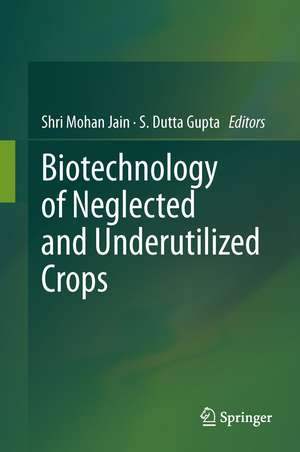Biotechnology of Neglected and Underutilized Crops
Editat de Shri Mohan Jain, S. Dutta Guptaen Limba Engleză Hardback – 30 apr 2013
| Toate formatele și edițiile | Preț | Express |
|---|---|---|
| Paperback (1) | 1219.46 lei 6-8 săpt. | |
| SPRINGER NETHERLANDS – 22 mai 2015 | 1219.46 lei 6-8 săpt. | |
| Hardback (1) | 1235.43 lei 6-8 săpt. | |
| SPRINGER NETHERLANDS – 30 apr 2013 | 1235.43 lei 6-8 săpt. |
Preț: 1235.43 lei
Preț vechi: 1506.62 lei
-18% Nou
Puncte Express: 1853
Preț estimativ în valută:
236.42€ • 245.33$ • 197.61£
236.42€ • 245.33$ • 197.61£
Carte tipărită la comandă
Livrare economică 15-29 martie
Preluare comenzi: 021 569.72.76
Specificații
ISBN-13: 9789400754997
ISBN-10: 940075499X
Pagini: 400
Ilustrații: VIII, 459 p.
Dimensiuni: 155 x 235 x 25 mm
Greutate: 0.95 kg
Ediția:2013
Editura: SPRINGER NETHERLANDS
Colecția Springer
Locul publicării:Dordrecht, Netherlands
ISBN-10: 940075499X
Pagini: 400
Ilustrații: VIII, 459 p.
Dimensiuni: 155 x 235 x 25 mm
Greutate: 0.95 kg
Ediția:2013
Editura: SPRINGER NETHERLANDS
Colecția Springer
Locul publicării:Dordrecht, Netherlands
Public țintă
ResearchCuprins
Preface.- Section I.- 1. The Genus Chenopodium – A Potential Food Source.- 2. Thin Cell Layer Technology in Micropropagation of Jatropha curcas L..- 3. New Achievements in Panax vietnamensis Research.- Section II.- 4. Molecular Biology and Physiology of the Resurrection Glacial Relic Haberlea rhodopensis.- 5. Cell Morphometry as Predictor of Protein Legume In Vitro Growth.- 6. Application of TILLING for Orphan Crop Improvement.- Section III.- 7. Neglected Oil Crop Biotechnology.- 8. Prospects for Quinoa (Chenopodium quinoa Willd.) Improvement through Biotechnology.- 9. Biotechnology of Eruca sativa Mill..- 10. Biotechnology of Stylosanthes.- 11. Biotechnology of Miscanthus.- Section IV.- 12. Tissue Culture and Genetic Transformation of Safflower (Carthamus tinctorius L.).- 13. Plant Regeneration and Genetic Transformation in Jatropha.- 14. Genetic Transformation of Bael (Aegle marmelos Corr.).- 15. Genetic Transformation of Taro.- 16. Bioprospecting and Genetic Engineering of MangroveGenes to Enhance Salinity Tolerance in Crop Plants.- Index.
Textul de pe ultima copertă
The world food supply depends on few crops species, termed as ‘major crops’. Almost 95% of the world food requirement is met by 30 plant species. There is a great need to broaden the exploitation of the plant genetic diversity in order to avoid dependence on few food crops. The neglected crops categorised as ‘minor crops’ have lesser importance globally in terms of production and market value. They could become an excellent source for useful gene source. Several factors such as physical appearance, taste, nutritional properties, cultivation methods, processing qualities, economic gains, etc. are responsible for the promotion and acceptance of ‘major crops’ worldwide. However, some crop species may be distributed worldwide but tend to have preference in the local ecology and local production and consumption system. They are traditionally grown in their centres of origin or in local farmers’ fields, important for the subsistence of local communities and constitutes an important part of the local diet nutrition. The lack of their genetic improvement is often hampered due to narrow genetic diversity.
This is the first comprehensive resource worldwide that reflects research achievements in neglected and underutilized crop biotechnology, documenting research events during the last three decades, current status, and future outlook. The book has 16 chapters, divided into 4 sections and provides information on Chenopodium as a potential food source, thin cell layer technology in micropropagation of Jatropha, and Panax vietnamensis; molecular biology and physiology of Haberlea rhodopensis, cell trait prediction in vitro and in vivo of legumes, and application of TILLING in orphan crops; biotechnology of neglected oil crops, Quinoa, Erucia sativa, Stylosanthes, and Miscanthus; genetic transformation of Safflower, Jatropha, Bael, Taro and genetic engineering of Mangroves. This book is useful for researchers, students, policy makers, and people with commercial interests.
This is the first comprehensive resource worldwide that reflects research achievements in neglected and underutilized crop biotechnology, documenting research events during the last three decades, current status, and future outlook. The book has 16 chapters, divided into 4 sections and provides information on Chenopodium as a potential food source, thin cell layer technology in micropropagation of Jatropha, and Panax vietnamensis; molecular biology and physiology of Haberlea rhodopensis, cell trait prediction in vitro and in vivo of legumes, and application of TILLING in orphan crops; biotechnology of neglected oil crops, Quinoa, Erucia sativa, Stylosanthes, and Miscanthus; genetic transformation of Safflower, Jatropha, Bael, Taro and genetic engineering of Mangroves. This book is useful for researchers, students, policy makers, and people with commercial interests.
Caracteristici
The first comprehensive resource worldwide that reflects research achievements in neglected and underutilized crop biotechnology Comprehensive reviews of selected neglected and underutilized crops 40 Colour illustrations











